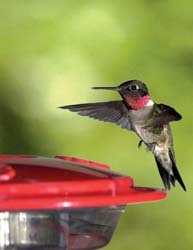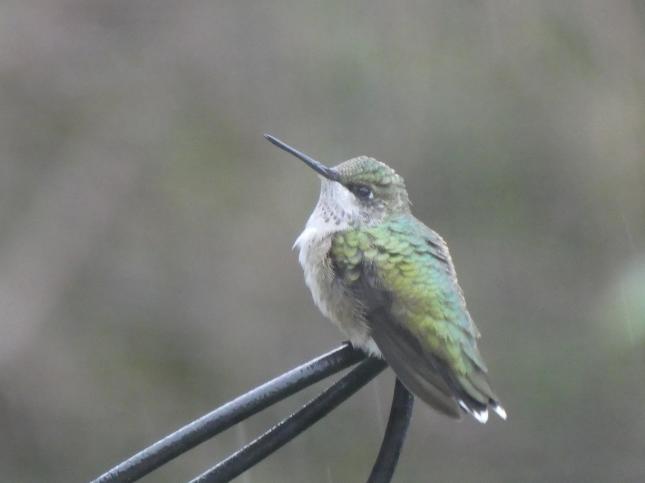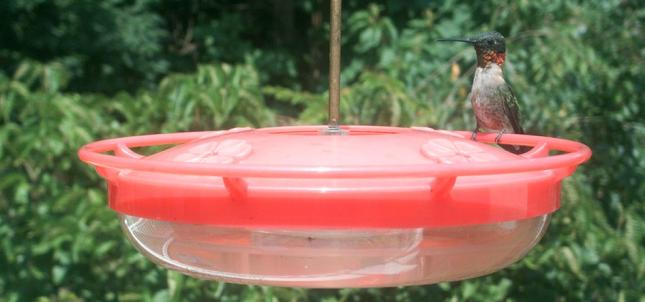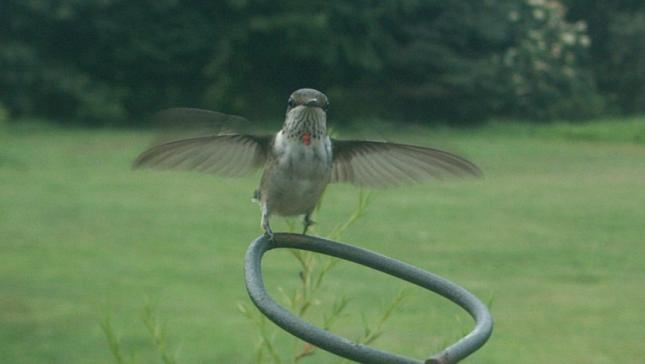All About Hummingbirds
Hummingbirds are one of the most beloved birds in our region, and arguably the cutest as well!
They generally arrive mid to late April. Get your feeders out, as Hummingbirds have been spotted in Delaware.
Here on the east coast we are only visited by one species of hummingbird: the Ruby-throated. Despite this, these little winged jewels captivate people of all ages with their adorable size, incredible speed, and bold personalities. Ruby-throated Hummingbirds spend their winters in Central America and Mexico. In the spring, Hummingbirds begin their long journey north to their breeding grounds all along the east coast of North America, even reaching into Canada. In our region, the first hummer sightings tend to occur around mid to late April. These first migrants don't tend to stick around for long. They usually are just dropping by for a sip before heading further north. Not to worry though, our local hummers are on the way and arrive by May.
How to Tell Who's Who
Determining if the hummingbird you are looking at is male or female is pretty easy when you only have one species around! Male Ruby-throated Hummingbirds are the inspiration for this species' name. They feature a flashy red throat patch that can sometimes appear black depending on your viewpoint. Female Ruby's lack that red color and instead have a bright white throat. Juvenile birds look very similar to the females, however their throat is more speckled than pure white.
 <male
<male  <female
<female
Hummingbird Behavior
Like other hummingbird species, Ruby-throated Hummingbirds get a large portion of their daily calories from nectar. They feed primarily from conical/trumpet shaped flowers such as honeysuckle, cardinal flower, bee-balm, and more. The sugar in the nectar helps them to fuel their incredibly fast metabolisms. To balance out all that sugar, hummers also eat a wide variety of small insects, including mosquitoes!
Hummingbirds are well known for their bold and sometimes aggressive behavior. They are not particularly shy birds and will come right up to your window to drink from a feeder. They tend to be quite feisty towards one another, even between males and females. In fact, the only time male and female hummers really get together is to "do the deed" and then they go their separate ways.
All parental care is done by the female Ruby. In late May through June, she will gather up materials to build her nest and have her eggs. Nests are made out of lichen and spider webbing and are roughly the size of a golf ball. She will lay one clutch per season containing two eggs. When the young hatch, the mama hummingbird does all the work of feeding the hungry babies until they are ready to fledge. During this nesting period, you may notice a drop in the number of hummingbirds you see in your yard. However, once the babies leave the nest, there will be lots of hummers buzzing around for you to enjoy - so get started with a feeder today!
Feeding Hummingbirds

Adding a hummingbird feeder to your yard is the best way to experience these beautiful little birds up close and personal. There are a few key features that make for a good hummingbird feeder:
- Easy to fill
- Easy to clean
- Colorful, preferably red (a hummers favorite color)
We typically recommend a saucer-style feeder like our High Perch Feeder (pictured above). They fulfill all the requirements of a good feeder, and even feature a perch ring that allows your hummingbirds to stop and take a breather after all that buzzing around. A tip for attracting the most hummingbirds: get more than one feeder. As previously mentioned, hummers are super feisty and can become territorial over food. Putting up a couple feeders around your yard makes it harder for one bird to take over all the food and chase away other hummingbirds.
Fill your feeders with nectar, which can easily be made at home. Use 1 part plain table sugar and 4 parts water. Boiling the sugar and water allows the sugar to dissolve better. Do not add red dye to your nectar, it is not necessary for attracting the birds and could potentially be unsafe for them to consume. You can store extra nectar in the fridge for easy refilling.
Regular changing of nectar and cleaning of your feeder is the key to maintaining a healthy food source for your backyard hummers. Nectar should be changed at least once a week in the spring. In the summer when temperatures are higher, every 2-3 days is necessary to keep the sugar from fermenting or molding. If the nectar ever looks cloudy change it. Between refills, make sure to give your feeder a good cleaning with hot water. Don't forget to scrub the feeding ports too!
Another great way to attract and feed hummingbirds is by planting native plants in your yard. This helps to create an attractive habitat for your birds that will help entice them to hang out in your yard even when they are not visiting your feeders. Choose plants that produce colorful tubular flowers that hummingbirds will enjoy. Your local garden center will often highlight hummingbird-friendly plants on the care tags.
For more information about hummingbirds and feeding, stop in and visit us! Our associates are happy to help answer any questions you may have.



